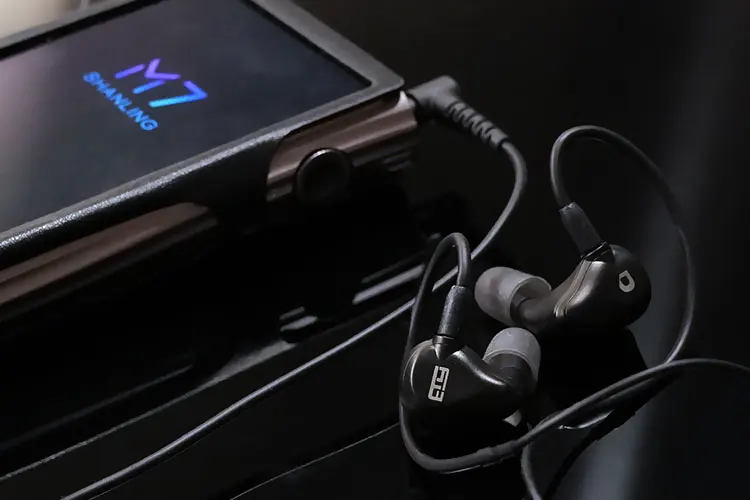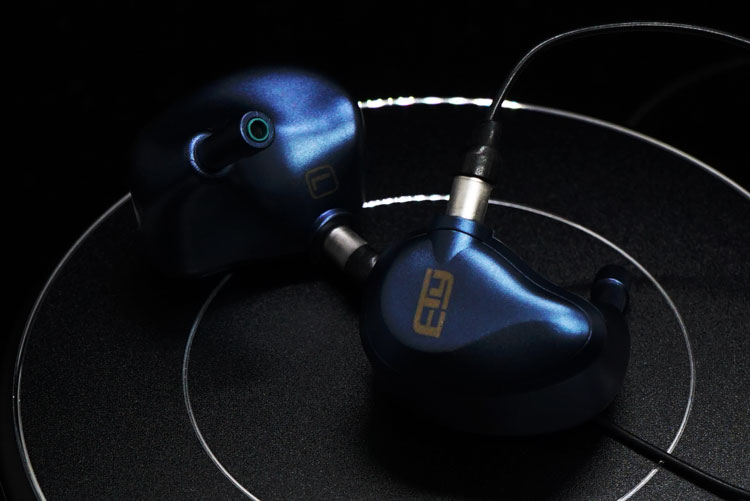Synergy
Efficiency
The ERX’s relatively high impedance at 47Ω suggests that it may need some extra power to shine. When testing on my laptop the sound intensity can go quite high but you may feel dynamics slightly lacking and the midrange not as defined when compared to plugging it on a dongle or a DAP with higher gain and output power.
Switching between a few devices the signature is quite consistent and the ERX is quite responsive to power to sound more dynamic and tighter in the lower register.
Pairings
The ERX can make use of DAPs with warmth to sound more intimate and engaging, such as the Shanling M7 which sounds highly textured, dynamic, and energetic.
The M7 also breathes a hint of warmth into the setup that makes Pops more enjoyable. It is also noticeable that the image holds more densely together when feeding more power to the ERX, and the overall detail retrieval level is enhanced.
Testing the ERX on the Cayin RU6 R2R dongle and listening to Pink Floyd albums, the output is smoothened and sounds more immersive and velvety. The bass sounds richer with a fuller body, despite it doesn’t boost the mid-bass density, it sounds more fun and contributes to the overall sense of serenity.
Select Comparisons
Etymotic EVO
£499.94
Technical
The Etymotic EVO utilizes 3 balanced armature drivers with a two-way crossover, joined by Linum BaX T2 cabling. The frequency response is also rated 20Hz-16kHz, identical to the ERX, and the impedance is rated at 47Ω and 99dB SPL in sensitivity, which is quite similar to the ERX as well.
Design
The ERX and EVO differ primarily in their color scheme and cables. Both models feature a sleek and modern metallic design, which represents a significant departure from the previous ER series.
This updated form factor showcases Etymotic’s proficiency in design, demonstrating its ability to innovate and evolve its product line.
When considering its price point, the ERX is one of the most well-constructed in-ear monitors available. However, it does not come with the more premium cable that is included with the EVO.
Performance
Priced at roughly half that of the EVO, the ERX features a single balanced armature driver, as opposed to the EVO’s multiple drivers design.
The EVO delivers a more robust technical performance, power, and resolution in the bass frequencies. Whereas, the ERX places less emphasis on the bass and mid-bass regions, resulting in a swifter and cleaner sound signature which may give it some edges when powered by weaker sources.
When tested with vocals, the EVO delivers a more upfront and separated presentation, while the ERX sounds more recessed, yet natural. This characteristic allows the ERX to be more forgiving with older recordings, although it may seem lacking in bass when listening to R&B or rock music.
It’s important to note that the ERX cannot match the EVO’s resolving power and bass quantity due to its single-driver design, which lacks dedicated drivers for each frequency range.
However, this single-driver configuration offers certain advantages, such as a more coherent and articulated response, especially at higher volumes. Despite its limitations, the ERX still delivers an engaging listening experience, particularly for those who prefer cleaner tuning.
Westone MACH 20
£399
Technical
The MACH 20 is a dual-driver in-ear monitor with a proprietary 2-way crossover design, with 1BA handling the bass and another BA for the rest of the spectrum. The MACH 20 comes with Linum Estron BaX as stock cable and is rated 96Ω in impedance and 110dB SPL in sensitivity.
Design
The MACH 20 offers a futuristic design that features a shallower fit when compared to the ERX. It is constructed with a lightweight polycarbonate material that is protected by a scratch-resistant finish and metallic faceplate.
While the MACH 20’s materials are marginally lighter than the ERX’s metallic jacket, the ERX’s full metallic design may appear more premium and reliable. Both IEMs are fitted with the T2 connector system and are similar in size, allowing both designs to be slimmer in profile.
Performance
Despite sharing some similarities, such as high impedance ratings, both have markedly different sound tuning approaches.
The MACH 20 is tuned to deliver a more intimate vocal experience with a warmer tone, while the ERX’s swift and laid-back tuning prioritizes clarity. In practice, the MACH 20 is more dependent on the source’s decoding quality and power, while the ERX is more forgiving in terms of tuning and could be powered by more devices at ease.
In terms of sound quality, the MACH 20, with its additional driver, delivers a thicker and more intense bass that extends deeper than the ERX. While the bass is more defined on the MACH 20, it requires more power from the source to achieve detailed performance.
When powered by a laptop, the ERX sounds cleaner than the MACH 20. The MACH 20 would need a higher-powered source that can bring out its full potential if not it will sound more compressed and unnatural.
In terms of sound signature, the MACH 20 places the midrange and vocals more upfront, creating a more intimate listening experience compared to the ERX’s laid-back presentation.
Both IEMs have a similar tuning approach to the treble, aiming for a rounded and inoffensive sound. However, the ERX’s tuning is more accurate and flatter across the frequency spectrum, allowing for greater detail and a more neutral tonal balance. As a result, it may be more suitable for critical listening applications.
Our Verdict
The Drop x Etymotic ERX is built to last with a durable design, and it is an excellent choice for those who prioritize accuracy and clarity in their audio gear. The IEM’s natural sound reproduction ensures extended listening sessions without fatigue, and its passive noise isolation power is unrivaled.
Etymotic has created an IEM reminiscent of their ER4 line, particularly the ER4XR, which has sought to achieve the perfect balance between technical performance and musicality.
The ERX has improved upon this with enhanced ergonomics, although some users may wish for a more premium cable, such as the Super BaX. Nevertheless, considering its price point, it deserves a solid recommendation.
Drop x Etymotic ERX Specifications
- Frequency response: 20Hz – 16KHz.
- Transducers: 1 BA per side
- Nominal Impedance: 45 Ohms @ 1kHz
- Sensitivity: 98 dB SPL for a 0.1Vrms input into IEC60318-4 ear simulator @1KHz
- Maximum Output: 120dB SPL
- Cable: 4-ft, with Estron T2 connectors





